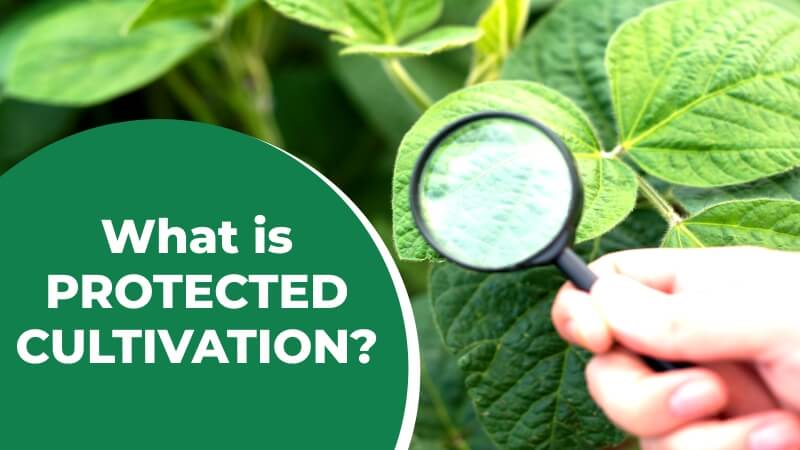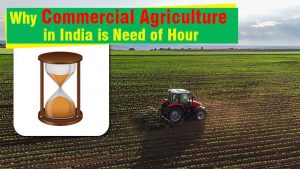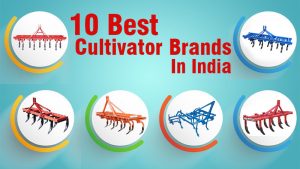Introduction:
Protected cultivation is defined as a cropping strategy where a plant’s growth and development are influenced by a regulated microclimate. As agriculture has developed, many protected cultivation techniques have been widely employed in industrial farming. Greenhouses, plastic houses, antique houses, internet houses, and shade houses are useful among these agriculture protection techniques. A greenhouse can be a framed or inflatable building that is lined with a clear or semi transparent material, allowing crops to grow to maturity within at least partially controlled conditions.
The key drivers of the Indian economy are agriculture and related sectors. A major concern following the Green Revolution is the emergence of numerous new biotic and abiotic stresses. By offering a fully regulated environment, protected cultivation techniques lessen these pressures. Thinking about protected farming is necessary given the rising food need. The most effective way for meeting the goals of protected horticulture is the greenhouse. The cultivation of many houses has become an important Indian agricultural policy.
Importance of Protected Cultivation:
It is no longer possible to ignore the growing urgency of the global issue of climate change. Anthropogenic factors, such as the unsustainable use of fossil fuels, the destruction of forests for industrial development, and the growing urbanization and overpopulation, are the key underlying causes.
- The crop is protected from frost, wind, rain, storms, and cold Because of controlled circumstances, plant growth is higher and harvests develop faster.
- Long-term improvements in manufacturing quality and output.
- Optimized water use results in a 40–50% reduction in usage.
- Effective use of the inputs.
- Disease and pest occurrence is decreased or eliminated Crops will reach their full maturity during the year.
- Can be used for star drying of farm produce.
- The best technology for industrial production of high-value commodities like flowers, medicinal plants, etc.
- The labor pool’s involvement will be minimized
- crop cultivation in adverse weather conditions
- To meet consumer demand, some crops are grown continuously.
- Fully-grown, premium-quality, even organic crops for export markets
- Income from small land holdings was greatly inflated.
- Successful nurseries prepared as and when needed from seeds or vegetative propagation
- More chances for educated kids to work for themselves on farms Controlling
- The greenhouse’s microclimate and bug-proof features breed plants, resulting in the development of modern types and the manufacturing of seeds.
Benefits of Protected Cultivation:
- Creation of transplants with improved genetics and no known diseases
Plant material that is homogeneous, healthy, and free of disease is a hallmark of protected farming. This planting medium has higher germination rates and improved hardening. This is due to the fact that greenhouse cucumbers and tomatoes are produced all over the world using disease-free, sterile, and inert substrates. You can be guaranteed that the transplants you receive will be healthier genetically and disease-free.
- Year-round production of fruit, vegetables, and flowers
The term “off-season” does not exist in protected horticulture. This implies that this agricultural technique is far more financially lucrative. Vegetables and fruits can be cultivated all year long. The year-round production of vegetables has been made possible by net buildings, walk-in tunnels, and shade.
- Increased agriculture output and productivity
Crop output is increased by sheltered growing methods. The output of vegetables and fruits is greatly increased when plants are planted closely together at a higher density.
Depending on the needs of the plant type, you can completely or partially manage the microclimate around the plant’s body. For instance, early nurseries of flowering annuals and vegetables can be expanded if low plastic tunnels are used.
- Promotes horticultural products with high quality and value
You can always count on high-quality horticultural products like cherries, capsicums, and melons from protected agriculture. The credit goes to the net houses if you’re wondering how. These structures aid in lessening the damaging effects of rain and the intense sun on plants, ornamentals, and vegetables.
- Reduces the application of insecticides
The concept of protected cultivation includes sustainability. The poly home serves to alter the microclimate, preventing some insects from entering.
- Increases output per unit of area
You can expect year-round cultivation if you have flawless plant environment control and the right structures, such as glasshouses.
- Little weed infestation and effective water use
By using a variety of structures to regulate the temperature, protected horticulture stops the growth of weeds. Low tunnels, shade net houses, polyhouses, and greenhouses are a few examples. The active zone of the roots can absorb more micronutrients when there are no weeds growing. By conserving soil moisture, this method lowers the need for irrigation water.
- Plants are not under biotic or abiotic stress.
Plants, as you may know, are sessile. They are unable to resist any biotic or abiotic stressors. Abiotic stress is associated with the physiographic, edaphic, and climatic conditions of the environment, while biotic stress is brought on by living things like fungi and weeds. However, one cropping method that protects plants from various pressures is protected culture.
- Cultivate uncommon and medicinal plants
Protected horticulture enables you to alter the natural environment for maximum plant growth. Crop yields can be increased by altering both the aerial and root environments. This implies you can develop a wide range of herbs, orchids, and other therapeutic plants using a greenhouse technique like sheltered culture.
Limitations of protected cultivation:
- High initial infrastructure costs (capital cost).
- Lack of skilled labor and local replacement of that labor.
- Lack of technical understanding of crop protection structures.
- Every single operation is incredibly time-consuming and demanding.
- Needs close monitoring and supervision.
- Some pests and pathogens that are found in soil are challenging to control.
- A significant challenge is a maintenance and repair.
- Requires confident marketing because a significant commitment of time, effort, and money is anticipated.
To get the latest updates on the tractor, tractor price, and tractor news install the KhetiGaadi application.




